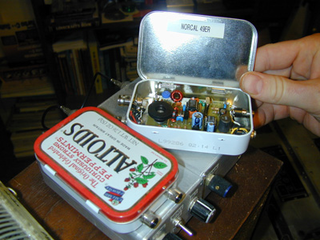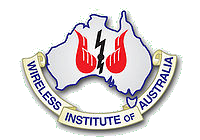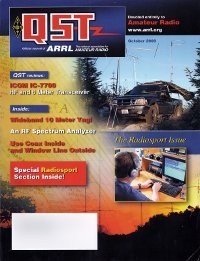
In amateur radio, QRP operation refers to transmitting at reduced power while attempting to maximize one's effective range. QRP operation is a specialized pursuit within the hobby that was first popularized in the early 1920s. QRP operators generally limit their transmitted RF output power to 5 W or less output for CW, or 10 W PEP output or less for SSB.

Radioteletype (RTTY) is a telecommunications system consisting originally of two or more electromechanical teleprinters in different locations connected by radio rather than a wired link. Radioteletype evolved from earlier landline teleprinter operations that began in the mid-1800s. The US Navy Department successfully tested printing telegraphy between an airplane and ground radio station in 1922. Later that year, the Radio Corporation of America successfully tested printing telegraphy via their Chatham, Massachusetts, radio station to the R.M.S. Majestic. Commercial RTTY systems were in active service between San Francisco and Honolulu as early as April 1932 and between San Francisco and New York City by 1934. The US military used radioteletype in the 1930s and expanded this usage during World War II. From the 1980s, teleprinters were replaced by personal computers (PCs) running software to emulate teleprinters.
The American Radio Relay League (ARRL) is the largest membership association of amateur radio enthusiasts in the United States. ARRL is a non-profit organization, and was co-founded on April 6, 1914, by Hiram Percy Maxim and Clarence D. Tuska of Hartford, Connecticut. The ARRL represents the interests of amateur radio operators before federal regulatory bodies, provides technical advice and assistance to amateur radio enthusiasts, supports a number of educational programs and sponsors emergency communications service throughout the country. The ARRL has approximately 161,000 members. In addition to members in the US, the organization claims over 7,000 members in other countries. The ARRL publishes many books and a monthly membership journal called QST.

The Wireless Institute of Australia (WIA) was formed in 1910, and is the first and oldest national amateur radio society in the world. It represents the amateur radio operators of Australia as the AR "peak body" in dealings with the Australian Communications and Media Authority (ACMA), the authority under the government of Australia that administers communications within and external to Australia. The WIA publishes a bi-monthly journal for its membership called Amateur Radio. The organisation is the national society representing Australia in the International Amateur Radio Union.

Field Day is an annual amateur radio contest, widely sponsored by IARU regions and member organizations, encouraging emergency communications preparedness among amateur radio operators. In the United States, it is typically the largest single emergency preparedness exercise in the country, with over 30,000 operators participating each year. Field Day is always the fourth full weekend of June, beginning at 18:00 UTC Saturday and running through 20:59 UTC Sunday.

Contesting is a competitive activity pursued by amateur radio operators. In a contest, an amateur radio station, which may be operated by an individual or a team, seeks to contact as many other amateur radio stations as possible in a given period of time and exchange information. Rules for each competition define the amateur radio bands, the mode of communication that may be used, and the kind of information that must be exchanged. The contacts made during the contest contribute to a score by which stations are ranked. Contest sponsors publish the results in magazines and on web sites.
The Journal is a daily newspaper produced in Newcastle upon Tyne. Published by ncjMedia,, The Journal is produced every weekday and Saturday morning and is complemented by its sister publications the Evening Chronicle and the Sunday Sun.

QST is a magazine for amateur radio enthusiasts, published by the American Radio Relay League (ARRL). It is a membership journal that is included with membership in the ARRL. The publisher claims that circulation of QST in the United States is higher than all other amateur radio-related publications in the United States combined. Although an exact number for circulation is not published by the American Radio Relay League, the organization claimed 158,238 members at the end of 2021, almost all of whom receive the magazine monthly, in addition to issues delivered to libraries and newsstands.
Like most other sports, amateur radio contesting has its share of disputes and controversy. These disputes are long-standing and may see no thorough resolution for a long time. They are presented for their informational value, with the positions in dispute summarized. There are several online forums where these topics are discussed.
Amateur radio frequency allocation is done by national telecommunication authorities. Globally, the International Telecommunication Union (ITU) oversees how much radio spectrum is set aside for amateur radio transmissions. Individual amateur stations are free to use any frequency within authorized frequency ranges; authorized bands may vary by the class of the station license.

The World Radiosport Team Championship is an amateur radio competition. Participation is by invitation only. Entry to each quadrennial WRTC requires qualification through high positions in major world radio contests. The main principle of the WRTC is to provide a level playing field for the qualified contestants from around the world to compete against one another using amateur radio stations located in areas with the same propagation terrain and equipped with identical antennas, operating under the keen eyes of qualified referees. Each WRTC event is organised by a volunteer group of Radio Amateurs in the locality where the competition will be held with the help of a standing committee of internationally recognized contesters. The WRTC is the closest thing to a world championship in the sport of radio contesting. In 2018 over 1000 people are involved with a cost of over half a million Euros. WRTC2018 web page
The New Zealand Association of Radio Transmitters (NZART) is a non-profit organisation of amateur radio enthusiasts in New Zealand. It represents New Zealand amateur radio operators nationally and internationally. NZART is a founding member of the International Amateur Radio Union. It is an association of individual members, however those members are encouraged to form local branches.

Vintage amateur radio is a subset of amateur radio hobby where enthusiasts collect, restore, preserve, build, and operate amateur radio equipment from bygone years, such as those using vacuum tube technology. Popular modes of operation include speaking over amplitude modulation (AM), and communicating using Morse code through continuous wave (CW) radiotelegraphy. Some enthusiasts have interest in owning, restoring and operating vintage military and commercial radio equipment such as those from 1940s to 1960s. Some undertake to construct their own gear, known in ham slang as homebrewing, using vintage parts and designs. A number of amateur radio clubs and organizations sponsor contests, events, and swap meets that cater to this specialized aspect of the hobby.
Homebrew is an amateur radio slang term for home-built, noncommercial radio equipment. Design and construction of equipment from first principles is valued by amateur radio hobbyists, known as "hams", for educational value, and to allow experimentation and development of techniques or levels of performance not readily available as commercial products. Some items can be home-brewed at similar or lower cost than purchased equivalents.

CQ Amateur Radio is a magazine for amateur radio enthusiasts first published in 1945. The English language edition is read worldwide; Spanish language edition is published in Spain with some translations of articles from the English language edition and some original European content. The magazine was also published in France with partial translation of the original edition between 1995 and 2000. Published by CQ Communications, the title is based on the CQ call.
QEX is a bimonthly magazine published by the American Radio Relay League. The magazine covers topics related to amateur radio and radiocommunication experimentation. The magazine features advanced technical articles on the theory, design, and construction of radio antennas and equipment. The magazine is published in English and has a worldwide subscription base.

KPH is a coast radio station on the Pacific Coast of the United States. For most of the 20th century, it provided ship to shore communications including telegrams and marine telex service. The station discontinued commercial operation in 1998, but is operated occasionally as a historic service – its signal can be received over a large portion of the western hemisphere.
The Union of Swiss Short Wave Amateurs is a national non-profit organization for amateur radio enthusiasts in Switzerland. The organization uses the German language acronym USKA. USKA is incorporated under Article 60 of the Swiss Civil Code and lists as its missions representing the interests of the amateur radio operators of Switzerland before national and international regulatory agencies, advancing the scientific art of radio, supporting emergency communications, and sponsoring contests. USKA is the national member society representing Switzerland in the International Amateur Radio Union.
The Royal Union of Belgian Radio Amateurs (UBA) is a national non-profit organization for amateur radio enthusiasts in Belgium. UBA is the national member society representing Belgium in the International Amateur Radio Union.

Amateur radio, also known as ham radio, is the use of the radio frequency spectrum for purposes of non-commercial exchange of messages, wireless experimentation, self-training, private recreation, radiosport, contesting, and emergency communications. The term "amateur" is used to specify "a duly authorized person interested in radioelectric practice with a purely personal aim and without pecuniary interest"; and to differentiate it from commercial broadcasting, public safety, or professional two-way radio services.










